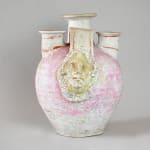Canosan Terracotta Funerary Vessel, 400 BCE - 300 CE
Terracotta
height 47.6 cm
height 18 3/4 in
height 18 3/4 in
PF.5610
Further images
The Greek colonies of Southern Italy, known in antiquity as Magna Graecia, were marked by their initial allegiance to the ceramic styles of the Attic mainland. However, over the years,...
The Greek colonies of Southern Italy, known in antiquity as Magna Graecia, were marked by their initial allegiance to the ceramic styles of the Attic mainland. However, over the years, native traditions and innovations heavily influenced the works of Magna Graecian potters. Unorthodox forms and painting-styles were seamlessly merged with the standard Greek style, creating distinctive works of art unique to the Hellenistic world. This funerary vessel comes from the region of Canosa, named after the ancient city in northern Apulia. Canosan ceramics are characterized by soft pastel-hued polychrome paint that decorates the surface of the works and reminds us what a vibrant colorful place the classical world really was. Rarely do more than traces of the paint survive the ravages of time, making the extensive pink and yellow hues that decorate this vessel ever more remarkable. This large container features a swollen belly with three spouts and a central handle. An appliqué face of a woman has been attached to the side of the vessel, directly under one of the spouts. Women are one of the most popular subjects in Canosan iconography, and the beauty and allure of this woman’s visage is certainly typical of the style. One wonders who this woman might be? A goddess protecting over the libations once contained within the vessel? A deceased wife or mother whose relatives commissioned this work as a funeral offering? While we will never know the answer to this intriguing mystery, we do know that similar works were typically interred as burial offerings to provide for the deceased throughout eternity. Although the person in whose honor this masterpiece was created has long since departed, the beauty and majesty of this work continues to enchant us, a stunning reminder of the glories of the classical world.
Literature
V29
1
of
7





